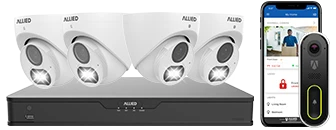Introduction to Smart Home Systems and Environmental Impact
Smart home systems have emerged as a pivotal development in modern technology, offering an array of benefits that extend beyond convenience and security. These systems integrate advanced automation and control features for various household functions, such as lighting, heating, ventilation, and air conditioning (HVAC), and appliances. By leveraging Internet of Things (IoT) technology, smart home systems enable homeowners to optimize energy usage, reduce waste, and minimize environmental impact.
The environmental impact of traditional homes has been a growing concern due to their substantial energy consumption, significant water usage, and high carbon emissions. Replacing conventional home systems with smart technologies can mitigate these environmental issues. The key components of smart home systems include smart thermostats, lighting controls, energy monitoring devices, and water management systems.
One of the prominent advantages of smart home systems is their ability to enhance energy efficiency. For instance, smart thermostats can learn homeowners’ patterns and adjust temperatures accordingly, which can lead to significant reductions in energy consumption. According to a study by the American Council for an Energy-Efficient Economy (ACEEE), smart thermostats can reduce heating and cooling costs by up to 10-15% annually.
Smart lighting systems also contribute to energy savings by allowing users to control lighting remotely, set schedules, and utilize motion sensors. This reduces unnecessary usage and conserves energy. The U.S. Department of Energy (DOE) highlights that LED smart bulbs can use at least 75% less energy and last 25 times longer than incandescent lighting.
Water conservation is another critical area where smart home systems make a noteworthy impact. Smart irrigation systems, for example, use weather data and soil moisture sensors to water lawns and gardens more efficiently. The Environmental Protection Agency (EPA) states that homes with smart irrigation systems can save up to 15,000 gallons of water annually.
| Smart Home Component | Environmental Benefit |
|---|---|
| Smart Thermostats | Reduce heating and cooling energy consumption by 10-15% |
| Smart Lighting | Use 75% less energy and last 25 times longer than traditional bulbs |
| Smart Irrigation Systems | Save up to 15,000 gallons of water annually |
By integrating these technologies, smart homes have the potential to significantly lower the environmental footprint of households. Their implementation in cities like San Antonio, which aims to foster sustainability, can lead to substantial environmental benefits. Such adoption not only aids in reducing resource consumption but also promotes a more sustainable and eco-friendly community.
Energy Consumption and Efficiency in San Antonio Homes
San Antonio, Texas, is a city that experiences hot summers and mild winters, making energy consumption for heating and cooling one of the top concerns for homeowners. Energy efficiency is crucial not only for the reduction of utility bills but also for environmental sustainability. Smart home systems offer a range of solutions that contribute significantly to energy efficiency in residential settings.
One of the primary ways smart home systems improve energy efficiency is through smart thermostats. Devices like the Google Nest, Ecobee, and Honeywell Lyric learn homeowners’ schedules and adjust temperature settings accordingly. According to a study by the Environmental Protection Agency (EPA), energy-efficient thermostats can reduce heating and cooling costs by up to 10-15% annually. Given San Antonio’s climate, this reduction can lead to substantial energy savings over time.
Another important aspect of energy efficiency is the use of smart lighting systems. LED lights combined with smart bulbs such as Philips Hue or LIFX can be controlled remotely and set on schedules to ensure lights are only on when needed. The U.S. Department of Energy states that LED lights use at least 75% less energy than incandescent lighting. When integrated into smart home systems, the savings can be even more significant due to optimal usage patterns.
Home energy monitoring systems are also becoming increasingly popular. Tools like the Sense energy monitor provide real-time data on energy consumption, helping homeowners identify high-usage devices and appliances. According to a report by Energy Star, using such monitoring tools can lead to an additional 5-10% reduction in energy usage.
A significant amount of energy is consumed by household appliances. Smart appliances, including refrigerators, washing machines, and dishwashers, often come with energy-saving modes and can be scheduled to run during off-peak hours, reducing strain on the grid and lowering utility costs. For instance, the Consumer Technology Association (CTA) reports that smart washing machines can reduce water and energy usage by up to 20%.
Lastly, window sensors and smart blinds can help in maintaining indoor temperatures by adjusting to the sunlight and temperature conditions. This can minimize the reliance on heating and cooling systems. Studies show that using these smart systems can result in energy savings of around 10% per year.
In conclusion, the adoption of smart home systems in San Antonio provides tangible benefits in terms of energy consumption and efficiency. These technologies not only contribute to lower energy bills but also play a crucial role in reducing the environmental impact of residential energy use.
Water Conservation through Smart Home Technology
Smart home technology can play a significant role in water conservation, particularly in areas like San Antonio, where water resources are precious. Implementing smart systems in homes enables more efficient water management, reducing unnecessary wastage and optimizing usage.
One notable feature of smart home systems for water conservation is the smart irrigation system. Traditional irrigation systems often over-water lawns and gardens, leading to excess water use. In contrast, smart irrigation systems utilize weather data, soil moisture levels, and plant types to adjust the watering schedule accordingly. According to the Texas Water Development Board, these advanced systems can reduce outdoor water use by up to 50%, which is particularly impactful during San Antonio’s hot and dry seasons.
Another technological advancement in smart homes is the smart leak detection system. These systems monitor water flow in real-time and can detect leaks or unusual usage patterns. In the event of a leak, the system can alert homeowners immediately or even shut off the water supply to prevent extensive water damage and wastage. The U.S. Environmental Protection Agency (EPA) estimates that household leaks can waste nearly 10,000 gallons of water annually, which can be significantly curtailed through smart leak detection.
The implementation of smart water heaters is also essential for water conservation. These devices can be programmed to heat water during off-peak hours or based on usage patterns, ensuring that water is heated only when necessary. This optimization not only saves energy but also reduces water waste from running taps while waiting for hot water. According to the Department of Energy, smart water heaters can curb water heating energy consumption by up to 10%.
Moreover, intelligent water monitoring systems allow homeowners to track real-time water usage via mobile apps or web interfaces. This transparency helps users identify high-usage activities and adjust their consumption habits accordingly. Data from the International Water Association indicates that informed consumers are more likely to conserve water, ultimately leading to reduced overall consumption.
Overall, the integration of smart home technology in San Antonio can significantly contribute to water conservation efforts. As these systems become more widespread and sophisticated, they offer promising avenues for optimizing water usage and ensuring the sustainability of water resources in the city.
Reducing Carbon Footprint with Smart Appliances
Reducing Carbon Footprint with Smart Appliances
Smart appliances are increasingly being adopted to reduce carbon footprints in homes, particularly in urban environments like San Antonio. These appliances include smart thermostats, energy-efficient lighting systems, and advanced HVAC systems.
Energy Efficiency of Smart Appliances
Smart appliances deliver significant carbon footprint reductions by optimizing energy usage. According to data from the U.S. Department of Energy, implementing smart thermostats can save homeowners an average of 10-15% on heating and cooling costs annually. Moreover, using smart lighting systems can reduce energy consumption by up to 75% when compared to traditional incandescent bulbs.
The following table illustrates the potential energy savings of various smart appliances:
| Appliance | Annual Energy Savings |
|---|---|
| Smart Thermostat | 10-15% |
| Smart LED Lighting | 75% |
| Smart HVAC Systems | 20-30% |
Impact on Carbon Emissions
The effective use of smart appliances translates to a noticeable decrease in carbon emissions. For instance, reducing energy consumption in homes directly impacts the amount of electricity that needs to be generated, predominantly from fossil fuels. According to a report by the Environmental Protection Agency (EPA), if one million homes were to adopt smart thermostats, it could reduce CO2 emissions by approximately 12 billion pounds annually, equivalent to taking 1.2 million cars off the road for an entire year.
San Antonio, a city that relies heavily on electricity from non-renewable sources, stands to benefit substantially from such reductions. A concerted effort to implement smart home systems across the city could mitigate the environmental impact, aligning with broader climate goals.
Conclusion
In conclusion, smart appliances present a viable solution for reducing the carbon footprint of homes in San Antonio. Enhanced energy efficiency, reduced energy consumption, and significant reductions in greenhouse gas emissions highlight the environmental benefits of adopting these technologies. As smart home systems continue to evolve, their potential for positive environmental impact will likely increase, making them an essential component of sustainable living practices in urban settings.
Case Studies: San Antonio’s Implementation of Smart Home Systems
San Antonio has been proactive in the integration of smart home technologies as part of its broader sustainability objectives. These case studies illustrate the practical benefits and real-world applications of smart home systems in the region.
Case Study 1: CPS Energy’s Smart Thermostat Program
CPS Energy, the primary electricity provider in San Antonio, has implemented a Smart Thermostat Program to optimize energy usage. Through this program, residents receive incentives to install smart thermostats that allow CPS Energy to manage and reduce energy consumption during peak periods.
According to CPS Energy, participants in this
program have collectively saved over 20 million kWh of electricity annually. This reduction in energy usage translates to a significant decrease in greenhouse gas emissions.
Case Study 2: Smart Water Meter Installation by SAWS
The San Antonio Water System (SAWS) has deployed smart water meters across the city to monitor and manage water usage more effectively. These meters provide real-time data, helping residents detect leaks and reduce water waste.
Data from SAWS indicate that the implementation of smart water meters has led to a 12% decrease in residential water consumption city-wide. This initiative plays a crucial role in conserving one of San Antonio’s most critical resources.
Case Study 3: Smart Lighting Solutions in New Residential Developments
Several new residential developments in San Antonio have adopted smart lighting systems to enhance energy efficiency. These systems use sensors and automation to adjust lighting based on occupancy and natural light availability, significantly reducing unnecessary energy use.
Studies from these communities show that smart lighting can decrease electricity consumption by up to 15%. This is especially beneficial as lighting typically accounts for a large portion of home energy use.
Case Study 4: Integration of Smart Appliances in Sustainable Housing Projects
Sustainable housing projects such as the “Ecovillage” initiative in San Antonio have incorporated smart appliances to enhance overall energy efficiency. These appliances are designed to optimize energy use and are often linked to solar energy systems to maximize renewable energy consumption.
Reports from these projects indicate that homes equipped with smart appliances can achieve energy savings of 30% compared to traditional homes. This not only lowers utility bills but also reduces the overall environmental footprint.
Government Policies and Financial Incentives for Smart Homes
The adoption of smart home systems in San Antonio is closely aligned with various government policies and financial incentives aimed at promoting environmental sustainability. The local authorities recognize the potential of smart technologies to enhance energy efficiency and reduce the ecological impact of residential areas.
The city of San Antonio participates in several programs meant to encourage homeowners to integrate smart home technologies. For example, CPS Energy, the largest municipally owned energy utility in the United States serving both residential and commercial properties, offers rebates and incentives for installing energy-efficient appliances and systems. These rebates can significantly offset the initial costs associated with upgrading to smart home technologies, making it more accessible for a broader range of residents.
Additionally, the State of Texas provides various tax incentives for energy-efficient home improvements. Homeowners in San Antonio can benefit from programs such as the Texas Property Assessed Clean Energy (PACE) financing. PACE allows property owners to finance energy efficiency, water conservation, and renewable energy installations, repayable through property assessments. This program helps alleviate the financial burden of smart home upgrades, promoting greater adoption rates.
Beyond state and local programs, federal initiatives also play a role. The U.S. federal government offers tax credits for certain energy-efficient improvements through the Energy Star program. These credits apply to a wide array of smart home technologies, including programmable thermostats, advanced HVAC systems, and energy-efficient windows. By taking advantage of these federal incentives, homeowners in San Antonio can further reduce their overall environmental impact while saving on energy costs.
Moreover, San Antonio’s commitment to sustainability is evidenced through its alignment with broader initiatives such as the Paris Climate Agreement. The city’s Climate Action & Adaptation Plan (CAAP) aims to achieve carbon neutrality by 2050. Smart home systems are an integral part of this plan, as they contribute significantly to reducing residential carbon emissions.
It’s also worth noting that local non-profit organizations and community groups are active in promoting awareness about the benefits of smart home technologies. These organizations often work in tandem with government programs to provide resources, workshops, and support for residents interested in making their homes more sustainable.
In summary, a combination of local, state, and federal policies, alongside various financial incentives, plays a crucial role in promoting the adoption of smart home systems in San Antonio. These measures not only support environmental sustainability initiatives but also provide tangible financial benefits to homeowners, encouraging broader implementation of smart technologies throughout the city.
Public Awareness and Community Initiatives in San Antonio
Public awareness and community initiatives play a crucial role in promoting the adoption of smart home systems in San Antonio. Several organizations and local government bodies are actively working to increase residents’ understanding and engagement in utilizing smart technology for environmental benefits.
The City of San Antonio, in collaboration with CPS Energy, has launched multiple outreach programs to educate residents about the advantages of smart home systems. These initiatives often include workshops, webinars, and informational campaigns aimed at demonstrating how smart devices can lead to significant energy and water savings.
Additionally, non-profit organizations such as Build San Antonio Green provide resources and support for homeowners interested in eco-friendly home improvements. These resources often feature guidance on incorporating smart home technology to reduce environmental impact effectively.
Community-driven projects also contribute to raising awareness about smart home systems. Neighborhood associations and local community centers frequently host events to discuss sustainable living practices, including the use of smart home devices. These gatherings offer practical demonstrations and peer discussions, empowering residents to make informed decisions.
Social media and local news outlets serve as important platforms for disseminating information about the environmental benefits of smart homes. Regular updates and success stories shared through these channels help maintain a steady flow of information, encouraging more residents to consider adopting smart technology.
Furthermore, partnerships between technology companies and local educational institutions foster a culture of innovation and environmental stewardship. By integrating smart home technology into educational programs, schools and universities in San Antonio are preparing future generations to prioritize sustainability in their daily lives.
Overall, public awareness and community initiatives in San Antonio are pivotal in promoting the environmental benefits of smart home systems. Through continuous education, hands-on experiences, and community engagement, residents are increasingly recognizing the positive impact that smart technology can have on the environment. This collective effort ensures that San Antonio remains at the forefront of sustainable living practices.
Future Prospects and Technological Advancements
The integration of smart home systems in San Antonio presents a promising future filled with continuous technological advancements that have substantial potential to amplify environmental benefits. As technology evolves, the capabilities of smart home systems are expected to expand, facilitating even greater energy efficiency, water conservation, and overall sustainability.
Emerging Technologies
Several emerging technologies are poised to revolutionize the smart home industry. Artificial Intelligence (AI) and machine learning are at the forefront, enabling more sophisticated and automated home management systems. These technologies can predict and optimize energy and water usage patterns, minimizing waste and reducing environmental impact.
- Advanced AI: Continual improvements in AI could provide more accurate predictive analytics, helping homeowners better manage their energy consumption.
- Internet of Things (IoT): Enhanced connectivity among smart devices is expected to offer seamless integration and smarter home automation.
- Blockchain Technology: Utilization of blockchain could ensure secure and transparent energy transactions, promoting the use of renewable energy sources.
Smart Grids and Renewable Energy
Smart grids represent a significant advancement that could facilitate more efficient energy distribution and consumption. These grids use digital technology to manage the production and distribution of electricity more effectively. By incorporating renewable energy sources, smart grids can significantly reduce carbon emissions.
Table 1 below illustrates the potential environmental benefits of integrating renewable energy and smart grids in residential areas:
| Technology | Environmental Benefit |
|---|---|
| Smart Grids | Optimized electricity distribution reduces energy waste. |
| Solar Panels | Clean energy production cuts down on fossil fuel reliance. |
Future Prospects in San Antonio
San Antonio has shown considerable initiative in adopting smart home technologies. Future prospects include increased collaboration between government bodies, private sector companies, and residents to foster a more sustainable urban environment.
Investment in research and development is crucial for advancing smart home technologies. Local universities and research institutions in San Antonio could play a pivotal role in driving innovations that benefit both the community and the environment.
Conclusion
The future of smart home systems in San Antonio is promising, with technologies continually evolving to provide more efficient, sustainable solutions. Embracing these advancements can lead to substantial environmental benefits, making San Antonio a leading example of a technologically advanced and environmentally conscious city.













